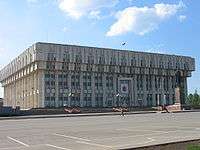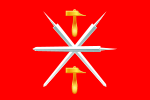Tula Oblast
| Tula Oblast Тульская область (Russian) | |||
|---|---|---|---|
| — Oblast — | |||
| |||
| |||
|
| |||
| Political status | |||
| Country | Russia | ||
| Federal district | Central[1] | ||
| Economic region | Central[2] | ||
| Established | September 26, 1937 | ||
| Administrative center | Tula | ||
| Government (as of March 2011) | |||
| • Governor | Alexey Dyumin[3] | ||
| • Legislature | Oblast Duma | ||
| Statistics | |||
| Area (as of the 2002 Census)[4] | |||
| • Total | 25,700 km2 (9,900 sq mi) | ||
| Area rank | 69th | ||
| Population (2010 Census)[5] | |||
| • Total | 1,553,925 | ||
| • Rank | 27th | ||
| • Density[6] | 60.46/km2 (156.6/sq mi) | ||
| • Urban | 79.4% | ||
| • Rural | 20.6% | ||
| Time zone(s) | MSK (UTC+03:00)[7] | ||
| ISO 3166-2 | RU-TUL | ||
| License plates | 71 | ||
| Official languages | Russian[8] | ||
| Official website | |||
Tula Oblast (Russian: Ту́льская о́бласть, Tulskaya oblast) is a federal subject of Russia (an oblast) with its present borders formed on September 26, 1937. Its administrative center is the city of Tula. The oblast has an area of 25,700 square kilometers (9,900 sq mi)[9] and a population of 1,553,925 (2010 Census preliminary results).[5] The current governor of the oblast is Alexey Dyumin (since 2 February 2016).[3]
History
People have inhabited Tula area since ancient times, as shown by discoveries of burial mounds (kurgans) and old settlements. These lands were occupied by the Slavic Vyatichi tribe, who cultivated the land, traded, and worked at crafts. This is confirmed by records in property registers, which mention an "ancient settlement" located at the place where the small Tulitsa River flows into the Upa River. In those long-ago times, its inhabitants may also have defended their settlements against raids by Tatars and nomadic tribes, but history is silent on this matter. The first mention of Tula is found in Nikon's chronicle in reference to the campaign of Prince Svyatoslav Olgovich of Chernigov. The chronicle notes that in 1146, the prince, who was heading for Ryazan, passed through a number of other settlements, including Tula, which at the time belonged to the Ryazan Principality.[10]
Geography
Tula Oblast is located in Russia's Central Federal District and borders Moscow, Ryazan, Lipetsk, Oryol, and Kaluga Oblasts.
Rivers
Tula Oblast contains more than 1,600 rivers and streams. Major rivers include:
Natural resources
The oblast is rich in iron ore, clay, limestone, and deposits of lignite (coal).[11] The lignite deposit is part of the Moscow coal basin.
Climate
Tula Oblast has a moderate continental climate, with warm summers and cold winters. Average January temperature is −10 °C (14 °F) in north and −9 °C (16 °F) in south. Average July temperature is about +19 °C (66 °F) to +20 °C (68 °F). Annual precipitation is 470 millimetres (19 in) in southeast and 575 millimetres (22.6 in) in northwest.
Politics

During the Soviet period, the high authority in the oblast was shared between three persons: The first secretary of the Tula CPSU Committee (who in reality had the biggest authority), the chairman of the oblast Soviet (legislative power), and the Chairman of the oblast Executive Committee (executive power). Since 1991, CPSU lost all the power, and the head of the Oblast administration, and eventually the governor was appointed/elected alongside elected regional parliament.
The Charter of Tula Oblast is the fundamental law of the region. The Tula Oblast Duma is the province's standing legislative (representative) body. The Oblast Duma exercises its authority by passing laws, resolutions, and other legal acts and by supervising the implementation and observance of the laws and other legal acts passed by it. The highest executive body is the Oblast Government, which includes territorial executive bodies such as district administrations, committees, and commissions that facilitate development and run the day to day matters of the province. The Oblast administration supports the activities of the Governor who is the highest official and acts as guarantor of the observance of the oblast Charter in accordance with the Constitution of Russia.
Administrative divisions
Demographics
Population: 1,553,925 (2010 Census);[5] 1,675,758 (2002 Census);[12] 1,867,013 (1989 Census).[13]
Ethnic composition (2010):[5]
- Russians - 95.3%
- Ukrainians - 1%
- Armenians - 0.6%
- Tatars - 0.5%
- Azeris - 0.4%
- Romani people - 0.3%
- Belarusians - 0.2%
- Germans - 0.2%
- Others - 1.5%
- 19,778 people were registered from administrative databases, and could not declare an ethnicity. It is estimated that the proportion of ethnicities in this group is the same as that of the declared group.[14]
- 2002 Census population:
- Urban: 1,366,818 (81.6%)
- Rural: 308,940 (18.4%)
- Males: 755,057 (45.1%)
- Females: 920,701 (54.9%)
- Females per 1000 Males: 1219
- Average age : 41.7 years
- Urban : 41.5 years
- Rural : 42.8 years
- Male : 37.8 years
- Female : 44.9 years
- 2012
2009 - 1.31 | 2010 - 1.31 | 2011 - 1.32 | 2012 - 1.43 | 2013 - 1.42 | 2014 - 1.47 | 2015 - 1.56(e)
Religion
According to a 2012 official survey[17] 62% of the population of Tula Oblast adheres to the Russian Orthodox Church, 2% are unaffiliated generic Christians, 1% are Muslims. In addition, 19% of the population declares to be "spiritual but not religious", 13% is atheist, and 3% follows other religions or did not give an answer to the question.[17]
Economy
Tula Oblast is part of the Central economic region. It is a prominent industrial center with metalworking, engineering, coalmining, and chemical industries.[19] Major industrial cities include Novomoskovsk and Aleksin. Historical industries, such as firearm, samovar, and accordion manufacturing, still play an important role in the region.
The oblast also has a developed agricultural sector, which ranks 33rd in Russia in agricultural production.[10] The sector includes farming grain (wheat and rye), potatoes, sugar beets, and vegetable growing, livestock raising, and dairying.
Culture

Tula Oblast has as many as 32 museums. Several are located in the administrative center of the oblast, the city of Tula, notably the Tula State Arms Museum, the Tula Kremlin, and the Tula Samovar Museum . Another important cultural tourist attractions is the home and country estate of Leo Tolstoy, Yasnaya Polyana, located 12 km outside of the city of Tula.
The oblast also has four professional theaters, a philharmonic orchestra, and a circus.
Notes and references
- ↑ Президент Российской Федерации. Указ №849 от 13 мая 2000 г. «О полномочном представителе Президента Российской Федерации в федеральном округе». Вступил в силу 13 мая 2000 г. Опубликован: "Собрание законодательства РФ", №20, ст. 2112, 15 мая 2000 г. (President of the Russian Federation. Decree #849 of May 13, 2000 On the Plenipotentiary Representative of the President of the Russian Federation in a Federal District. Effective as of May 13, 2000.).
- ↑ Госстандарт Российской Федерации. №ОК 024-95 27 декабря 1995 г. «Общероссийский классификатор экономических регионов. 2. Экономические районы», в ред. Изменения №5/2001 ОКЭР. (Gosstandart of the Russian Federation. #OK 024-95 December 27, 1995 Russian Classification of Economic Regions. 2. Economic Regions, as amended by the Amendment #5/2001 OKER. ).
- 1 2 "Путин принял отставку губернатора Тульской области Груздева". Lenta.ru. 2 February 2016.
- ↑ Федеральная служба государственной статистики (Federal State Statistics Service) (2004-05-21). "Территория, число районов, населённых пунктов и сельских администраций по субъектам Российской Федерации (Territory, Number of Districts, Inhabited Localities, and Rural Administration by Federal Subjects of the Russian Federation)". Всероссийская перепись населения 2002 года (All-Russia Population Census of 2002) (in Russian). Federal State Statistics Service. Retrieved 2011-11-01.
- 1 2 3 4 Russian Federal State Statistics Service (2011). "Всероссийская перепись населения 2010 года. Том 1" [2010 All-Russian Population Census, vol. 1]. Всероссийская перепись населения 2010 года (2010 All-Russia Population Census) (in Russian). Federal State Statistics Service. Retrieved June 29, 2012.
- ↑ The density value was calculated by dividing the population reported by the 2010 Census by the area shown in the "Area" field. Please note that this value may not be accurate as the area specified in the infobox is not necessarily reported for the same year as the population.
- ↑ Правительство Российской Федерации. Федеральный закон №107-ФЗ от 3 июня 2011 г. «Об исчислении времени», в ред. Федерального закона №271-ФЗ от 03 июля 2016 г. «О внесении изменений в Федеральный закон "Об исчислении времени"». Вступил в силу по истечении шестидесяти дней после дня официального опубликования (6 августа 2011 г.). Опубликован: "Российская газета", №120, 6 июня 2011 г. (Government of the Russian Federation. Federal Law #107-FZ of June 31, 2011 On Calculating Time, as amended by the Federal Law #271-FZ of July 03, 2016 On Amending Federal Law "On Calculating Time". Effective as of after sixty days following the day of the official publication.).
- ↑ Official on the whole territory of Russia according to Article 68.1 of the Constitution of Russia.
- ↑ http://www.gks.ru/bgd/regl/b11_14t/IssWWW.exe/Stg/centr/tula.htm
- 1 2 "TulaRegion". Kommersant Moscow. Retrieved 2006-10-31.
- ↑ "Tula Oblast". Merriam-Webster's Geographical Dictionary (2001). Retrieved 2006-10-31.
- ↑ Russian Federal State Statistics Service (May 21, 2004). "Численность населения России, субъектов Российской Федерации в составе федеральных округов, районов, городских поселений, сельских населённых пунктов – районных центров и сельских населённых пунктов с населением 3 тысячи и более человек" [Population of Russia, Its Federal Districts, Federal Subjects, Districts, Urban Localities, Rural Localities—Administrative Centers, and Rural Localities with Population of Over 3,000] (XLS). Всероссийская перепись населения 2002 года [All-Russia Population Census of 2002] (in Russian). Retrieved August 9, 2014.
- ↑ Demoscope Weekly (1989). "Всесоюзная перепись населения 1989 г. Численность наличного населения союзных и автономных республик, автономных областей и округов, краёв, областей, районов, городских поселений и сёл-райцентров" [All Union Population Census of 1989: Present Population of Union and Autonomous Republics, Autonomous Oblasts and Okrugs, Krais, Oblasts, Districts, Urban Settlements, and Villages Serving as District Administrative Centers]. Всесоюзная перепись населения 1989 года [All-Union Population Census of 1989] (in Russian). Институт демографии Национального исследовательского университета: Высшая школа экономики [Institute of Demography at the National Research University: Higher School of Economics]. Retrieved August 9, 2014.
- ↑ http://www.perepis-2010.ru/news/detail.php?ID=6936
- ↑ http://www.gks.ru/free_doc/2012/demo/edn12-12.htm
- ↑ http://www.gks.ru/wps/wcm/connect/rosstat_main/rosstat/ru/statistics/publications/catalog/doc_1137674209312
- 1 2 3 Arena - Atlas of Religions and Nationalities in Russia. Sreda.org
- ↑ 2012 Survey Maps. "Ogonek", № 34 (5243), 27/08/2012. Retrieved 24-09-2012.
- ↑ "Tula". Encyclopædia Britannica Online. Retrieved 2006-10-31.
See also
External links
| Wikimedia Commons has media related to Tula Oblast. |
 |
|
 | ||
| |
|
| ||
| ||||
| | ||||
| |
|



